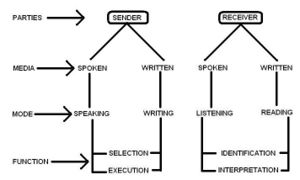 We use ‘communication’ usually to mean speaking or writing or sending a message to another person. Communication is really much more than that. It involves a number of choices and decisions but being natural and unnoticed in informal situations. In formal situations, our communication needs to be more effective and carefully chosen, that is, we need to plan our communication. Here comes the question what is Communication or how communication could be defined?
We use ‘communication’ usually to mean speaking or writing or sending a message to another person. Communication is really much more than that. It involves a number of choices and decisions but being natural and unnoticed in informal situations. In formal situations, our communication needs to be more effective and carefully chosen, that is, we need to plan our communication. Here comes the question what is Communication or how communication could be defined?Communication may be broadly defined as the process of meaningful interaction among human beings. More specifically, it is the process by which meanings are perceived and understandings are reached among human beings. – D.E. McFarland.
Looked at more closely, what is essential for communication to occur is the cooperation between two parties, one active or at the giving end and the other passive or at the receiving end.
The sender selects appropriate symbols to suit the situation and realizes the meaning through speech or writing depending upon the socially regulated requirements or self-perceived needs. At the receiving end the symbols are identified and identification obviously implies recognition and realization of meaning through the interpretive process.
The process of Communication may be summarized as follows:
Communication is thus a network of interactions and naturally the sender and the receiver keep on changing their roles.
Another aspect of communication is the deployment of a code consisting of arbitrarily evolved symbols and the determination of the appropriateness of their use in given situations, leading to the emergence of diverse communication patterns. A number of factors come into play in shaping these patterns. In fact, communication is often but not always momentary. At times communication is a cumulative process that starts before the actual communicative event takes place and continues after it has occurred. Thus communication therefore must acquire a true perspective of not only the present requirements of the situation but also its relationship with the past and its impact on the future.
Another aspect of communication is the deployment of a code consisting of arbitrarily evolved symbols and the determination of the appropriateness of their use in given situations, leading to the emergence of diverse communication patterns. A number of factors come into play in shaping these patterns. In fact, communication is often but not always momentary. At times communication is a cumulative process that starts before the actual communicative event takes place and continues after it has occurred. Thus communication therefore must acquire a true perspective of not only the present requirements of the situation but also its relationship with the past and its impact on the future.

No comments:
Post a Comment